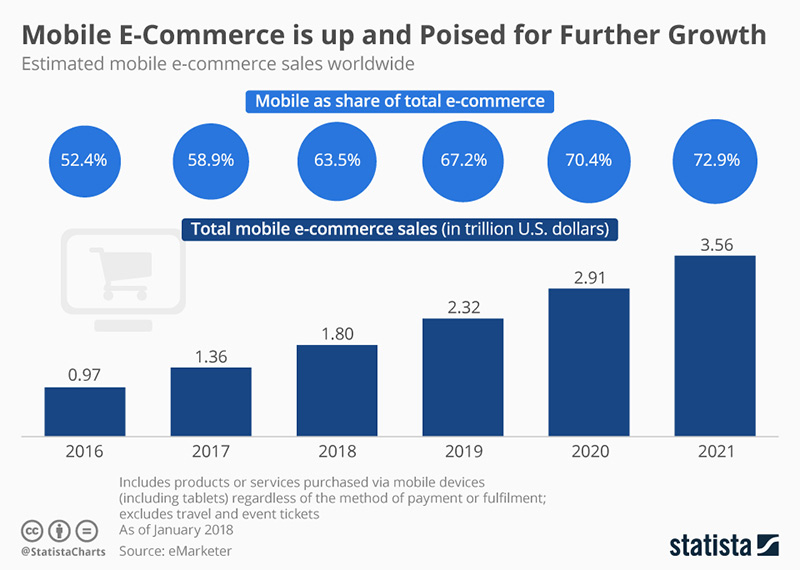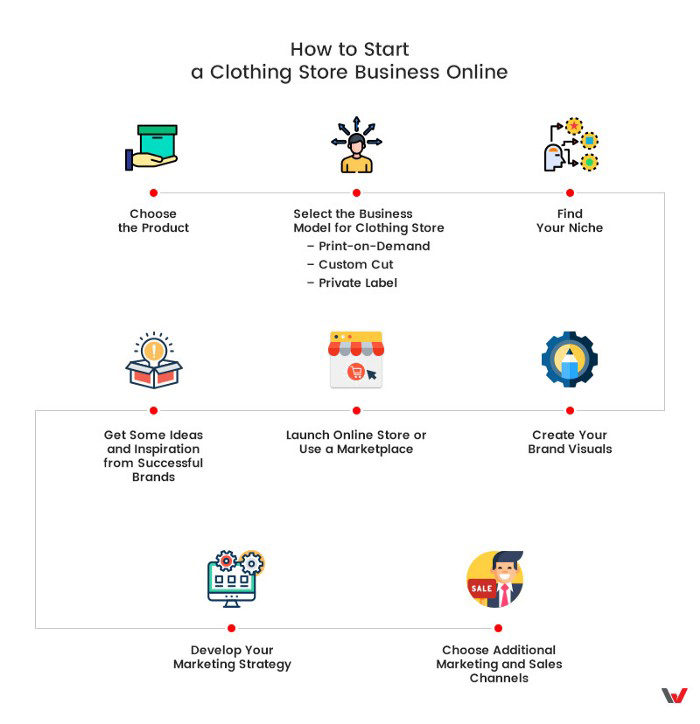Adobe’s digital economy insights reflect that going forward, two patterns will start becoming our “new normal”:
- Higher rates of e-commerce. The total online spending rose by 77%, hitting the $82.5 billion mark by May 2020.
- More demand for BOPIS (buy online, pick up in-store). This rose by 195% by May 2020.
Mobile commerce, or m-commerce, goes way beyond American borders. It covers 63.5% of all global eCommerce transactions today.

Source: statista.com
So the question is no longer whether to transition to eCommerce trading.
Rather, entrepreneurs have to start thinking about how to make online shopping easy and irresistible. This goes for any client or mobile device of their choosing.
But before you get here, you need the right foundation for your eCommerce clothing store.
Starting and running a successful clothing store online goes beyond designing clothing. It transcends the understanding of fashion trends. You also need a firm grasp of eCommerce business models available for clothing lines.
There are key foundational steps an entrepreneur should take to achieve resounding success:
Step 1: The Business Plan
As long as you plan to sell a product with the hope of gaining income, you need a solid business roadmap. Contrary to popular misinformation, business plans are not only meant for brick and mortar enterprises.
At the very least, your roadmap should have:
- A clear and definitive statement about your clothing brand
- An overview of your product offering(s)
- A clearly outlined sales and marketing strategy
In your business plan, you should dedicate research time to determine the price point.
To start a clothing line, figure out what customers are willing to pay for a product like yours. Customer and market trends often vary, so allow yourself some flexibility.
Get familiar with three main costs, i.e:
- Fixed expenses. These never change. They include business registration, website design, and initial branding.
- Software. An online business needs a couple of these and most of them have monthly charges.
- Production. From sourcing, manufacturer costs, shipping costs, and related expenses.
As you draft the business plan, consider:
- Your clothing brand value proposition
- The business model that suits you
- Up to date market analysis
- Starting up costs, legal costs, and financial management
A well thought out business plan is one that allows you to:
- Access current business ideas to determine their viability
- Factor in growth and scalability
- Identify key internal and external gaps that need resolution
- Define business goals and actionable strategies
- Hire the right support staff
- Find and cultivate solid partnerships.
- Secure funding for growth and development
- Differentiate your brand from competitors
Step 2: The Legal Matters
Before starting a clothing line, or beginning product negotiations with manufacturers, ensure that the legalities of your business are in perfect order.
To get started, carefully complete the following list of important tasks:
- Check if the business name you want is unregistered
- Find out whether the brand name domain and social media handles are available. They must not infringe on existing registered or copyrighted names/brands.
- Define your business entity. Will it be a sole proprietorship, S-corp, or LLC? Each business entity type has pros and cons. Choose one that best suits your online clothing store model.
- Register the business. Depending on the business entity type, you may need to officially register with the state in which your business operates. In other cases, you may choose to file a DBA ( doing business as) to officially register your business name.
- Secure required licenses and permits before initiating conversations with suppliers.
- Look into trademarking your original concepts.
- Get your employer identification number for tax purposes.
- Open a business bank account. Find options that give you access to business financing.
Step 3: The Target Audience
The importance of a powerful brand identity to an eCommerce business cannot be emphasized enough.
In the world of fashion, the brand is the sun. Everything else revolves around it. As a result, the clothing line business is highly competitive.
A clothing line touches on a very personal aspect of human nature. People’s clothing choices are shaped by their identities. The branding clothing labels they display are an extension of who they are. It is how they show up for themselves and to the outside world.
Who is your target audience? Without deep insight into this question, you will never effectively market your online clothing business. There are numerous ways to research the audience.
eCommerce is guided by internet access and patterns. Go where the numbers are. Have a look into Facebook groups, participate in online forums, carry out customized digital surveys. Collect as much data on your ideal clientele as is available. Information that allows you to build a fictional person that you’re selling to.
Use this simple checklist to create your ideal audience persona:
- Their Age / Gender
- Geographical location(s) and climatic conditions
- Interests and hobbies
- Career or profession
- Common pain points
- Race and ethnicity
- Sexual orientation
- Income and social status(es)
- What they need clothes like yours to do differently
- What key brand attributes they look for when buying
- Major issues experienced when buying clothes like yours
Build as many personas as you can to ensure you capture your target audience in its entirety. Effective buyer persona mapping has major benefits. From this research, you can customize your brand messaging to match their behaviors, concerns, and expectations more accurately.
Step 4: Finding Your Online Niche
The concept behind finding a niche is to create both focus and consistency for your brand.
Carving out a space for yourself amidst the millions online will give you more visibility and a better vantage point compared to your competition.
In the fashion business, a broad niche may sometimes be easier than a micro-niche. This is especially true when you have a general idea of what business direction you want to go to.
Examples of broad niches in the clothing line market include sportswear, sleepwear, casual wear, formal wear, or underwear. Micro niches dig deeper. They target exact audience-specific product segments like plus size lingerie, on-demand pet apparel, men’s’ fast fashion, etc.
In general, the key to success in a highly saturated or competitive market is finding and solving a unique problem. An unprecedented idea that appears in everyday situations could birth the concept of a unique apparel line.
A perfect example of this is Bee Yourself Apparel, founded by eCommerce entrepreneur Sherri Dombi. Hers is an adaptive clothing line that allows senior citizens and people with disabilities the freedom to dress themselves.
To frame your online niche, start thinking about :
- What identity your clothes will project
- What kind of people would want to wear your design(s)
- The unique thing people experience from buying into your brand. Can they get it elsewhere?
- Whether you are a low, medium, or high-end brand
Deep industry research is one of the best ways to zero in on untapped business potential. Take your time to do this right.
Another way to define your niche online is by “stalking” the competition. Start looking into other online apparel businesses from the biggest names to the newcomers. This gives you the best idea about what works for the audience.
Competitor analysis also gives insight into:
- Similar design and price point. People don’t like feeling hoodwinked by new businesses. They most certainly won’t pay a premium for something that can get at a lower price for the same quality.
- Brand messaging. Seeing the competition in action is one way to know how to make your voice unique and engaging.
- Customer experiences and expectations. Online reviews are a goldmine for competitor research. They help you see the mistakes you should try to avoid as an online store. They also help you find pain points that your business can address.
- Digital strategies. Using digital tools like SEMRush can help you find crucial keywords, topics, or backlinks related to your industry.
Once you fulfill the above steps, you are ready for the next stages of kicking off your successful clothing line i.e:
- Creating your web presence. Strong website design lends credibility to your e-business. Make sure your website design considers mobile screens. This is an important eCommerce compliance aspect at present. Ensure that the customer journey is as seamless and as interactive as possible. Pay close attention to your online store’s functionality too.
- Designing your first collection. With the foundation in place, start thinking about the garments that will be available in your online store. The first complete collection should mirror the essence of your clothing line. It should leave no doubt regarding what is unique about your design aesthetic. Always be true to your brand positioning.
- Finding the right manufacturer. This is going to be one of your most vital business relationships. Manufacturing covers a large percentage of your budget, so you need to focus on keeping healthy profit margins. This is the business vendor who transforms your design vision into a physical reality. Therefore you need to make the right choice for your business model. Preview as many factory locations as you can before sealing the deal.
- Getting the word out. Learn how to promote your brand using social media. Use external bloggers and influencers to push your product. Instagram is quite popular for visual content. It would do wonders for your lookbooks. Think seriously about leveraging content creation and marketing to raise awareness and attract high-quality leads. Initiate media partnerships that you could plug your brand into. Consider becoming a sponsor to a cause related to your brand.

Source: medium.com
Fuel Your Ambition: Your eCommerce Community Awaits
One of the best things an entrepreneur can do for themselves is to find a high-value business network.
This is what’s in store for you within the eCommerceFuel community. We offer support to online entrepreneurs by:
- Facilitating deep business relationships,
- Helping entrepreneurs grow their business,
- Sharing insightful business and marketing content, and
- Providing growth capital to 7+ figure store owners.
We value discretion above all else. eCommerceFuel is a private community made up of long-time, industry-savvy entrepreneurs.
We are currently the largest community online for 7-figure + eCommerce store owners.
Apply to join and gain insight from our 1000+ members today.
Photo by freepik from rawpixel

 One of the most important factors in off-site Search Engine Optimization (SEO), is backlinks. A backlink is simply a link from another website, to your website. Search engines see links as “votes”, so the more links, and quality, relevant links…
One of the most important factors in off-site Search Engine Optimization (SEO), is backlinks. A backlink is simply a link from another website, to your website. Search engines see links as “votes”, so the more links, and quality, relevant links…